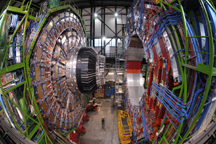
| RELATED WEB SITES |
| * Purdue Particle Physics |
| * Purdue High Energy Astrophysics Group |
| * CMS |
| * LHC |
| RELATED NEWS RELEASES |
| * Universities prepare as physicists plan to pop protons |
| * Purdue scientists, students help create a key piece of one of the world's most powerful cameras |

September 12, 2008
World's largest particle accelerator goes live; Purdue Web site to share the action
WEST LAFAYETTE, Ind. - |
A Purdue team created a Web site to introduce the experiment and equipment to high school students, teachers and the general public. The site also offers an opportunity to ask questions and obtain more information from the group.
The site, located at https://www.physics.purdue.edu/particle/lhc, includes videos of experiments along with descriptions, photos and diagrams of the equipment. It also includes links to Web sites of the European Organization for Nuclear Research, CERN, which is responsible for the experiment. Links take students to a YouTube rap video about the project, live Web cams following the action, movies explaining the physics and blogs from students involved in the project.
"We want to encourage students to share in this exciting scientific time and have created a space for them to explore the universe right along with us," said Virgil Barnes, a Purdue professor of physics and member of the Purdue team. "The Compact Muon Solenoid, or CMS, detector will sit at the most powerful particle accelerator ever built, the Large Hadron Collider, and will record the floods of particles coming from mini Big Bangs created when two beams of 7 Trillion-electron-volt protons collide head-on in the center of our huge detector. We hope to find new kinds of particles, which can hold the key to a better understanding of our universe - how it all began and where it is headed. It is even possible that the LHC could give us hints of tiny unseen extra dimensions of space, if they exist. The Web site includes a lot of visual and interactive elements and explains the science in a fun, interesting and understandable way."
Rob Spencer, a physics teacher at West Lafayette High School, added the Purdue site to his classroom Web page and plans to incorporate the experiment into future lessons.
"Current events are important teaching tools and can really get students excited about what they are studying, but teachers need reliable sources like Purdue to put together easily accessible and student-targeted educational sites," Spencer said. "The traditional ramps and springs used to teach physics give students hands-on experience in a classroom, but it is always beneficial to bring in real situations. This is true not just for physics or science, but for any subject."
In addition to Barnes, the team includes physics professors Daniela Bortoletto, Art Garfinkel, Laszlo Gutay, Matthew Jones, David Miller, Norbert Neumeister and Ian Shipsey, as well as postdoctoral research personnel, engineers, graduate students and undergraduate students.
Tens of thousands of physicists and engineers collaborated to construct the more than $10 billion Large Hadron Collider and its detectors located near Geneva, Switzerland. It uses a 27-kilometer ring of superconducting magnets deep underground to store and collide head-on beams of protons at an energy seven times greater than has ever been previously achieved on Earth, Barnes said.
The collisions of protons at these extreme energies will expose the microscopic subatomic world and massive, state-of-the-art detectors such as the CMS are needed to detect the products of these collisions. The results could yield new discoveries about the underlying structure of matter.
The Purdue Particle Physics group is a major participant in the CMS experiment. The group has been in existence for 50 years and has been involved in discovering some of the fundamental building blocks of matter.
In collaboration with other universities and national laboratories, the Purdue Particle Physics group has made extensive contributions to the CMS experiment during the past decade. The group helped design and construct critical pieces of equipment for the experiment. More information about the group's contributions is available at https://www.physics.purdue.edu/particle/lhc/purdue-lhc.
Writer: Elizabeth Gardner, (765) 494-2081, ekgardner@purdue.edu
Sources: Virgil Barnes, (765) 494-5199, barnes@purdue.edu
Rob Spencer, spencerr@wl.k12.in.us
Additional Contacts:
Daniela Bortoletto, (765) 494-5197, daniela@physics.purdue.edu
Art Garfinkel, (765) 494-5196, garfinke@purdue.edu
Laszlo Gutay, (765) 494-5047, gutay@purdue.edu
Matthew Jones, jones105@purdue.edu
David Miller, (765) 494-5556, miller@physics.purdue.edu
Norbert Neumeister, (765) 494-5198, neumeist@purdue.edu
Ian Shipsey, (765) 494-5391, shipsey@physics.purdue.edu
Purdue News Service: (765) 494-2096; purduenews@purdue.edu
IMAGE CAPTION:
The CMS detector. (Photo courtesy of CERN/Maximilien Brice)
A publication-quality photo is available at https://www.purdue.edu/uns/images/+2008/cms-detector.jpg
To the News Service home page
